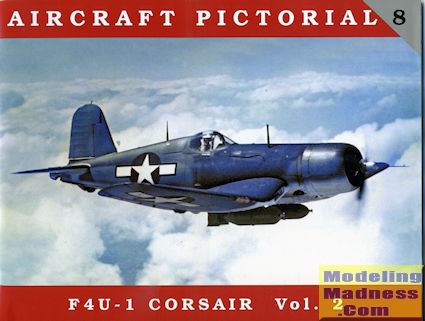Aircraft Pictorial #8: F4U-1 Corsair
Vol 2
 After much
acclaim, we now have the second volume on the F4U-1 Corsair. This volume
concentrates on the rest of the -1 series. The author notes that during the war,
there was no '-1A' F4U. That was used by Vought to help differentiate the new
variant from the birdcage Corsair. While the nomenclature was not officially
approved, the terminology did start to see wider use in the service. Not so the
-1C and -1D which were given the blessings of BuAer.
After much
acclaim, we now have the second volume on the F4U-1 Corsair. This volume
concentrates on the rest of the -1 series. The author notes that during the war,
there was no '-1A' F4U. That was used by Vought to help differentiate the new
variant from the birdcage Corsair. While the nomenclature was not officially
approved, the terminology did start to see wider use in the service. Not so the
-1C and -1D which were given the blessings of BuAer.
The book looks at all of the different
versions including those built for the British as well as those produced by
Brewster and Goodyear. Urban legend has it that the Brewster built Corsairs were
inferior aircraft and that is not true. Brewster was simply poorly managed and
eventually lost its contract to build the plane. Most British Corsairs were
built by Brewster. Brewster also developed the centerline bomb rack and the
shorter wing tips for British Corsairs. In fact there were two different
shortened tips for the FAA planes as newer British carriers had even less
overhead room and required a 'short-short' wing tip. This item was easily
retrofitted as required.
The British Corsairs were also initially
provided in US spec FAA camouflage that differed from home brew camouflage
paints. Later, the FAA accepted planes in overall gloss sea blue. These planes
were fitted with British specific equipment. Not so those supplied to the Royal
New Zealand Air Force which operated planes straight off US assembly lines.
The other company that made the Corsair
was Goodyear. Nearly 1/4 of their -1 production was made with no tail hook and
fixed wings until 1944 when the Navy decided to start operating Corsairs from
carriers. This occurred due to the Kamikaze threat and the additional speed of
the Corsair over the Hellcat mandated their placement on ships to counter the
threat. Eventually the Corsair saw much more widespread fleet use and post war,
the more sedate Hellcat quickly disappeared from the inventory while the Corsair
kept being produced.
Other variants produced were the cannon
armed -1C, a plane very much appreciated by the Marines who wanted all cannon
armed planes and the improved -1D. This aircraft had two inner wing racks that
could be used to hold either bombs or fuel tanks. Originally only the right rack
was plumbed for fuel but eventually both were and many were retrofitted. Same
goes for the canopy which was developed to remove all the frames and could be
refit to earlier aircraft. The -1D also had provisions for outer wing rocket
rails though not all planes were so equipped.
There were numerous other changes
including radios, gun sights and antenna configurations, much of the latter
brought on by the frequent breaking of the plane's pole antennas. Even plastic
wing tips were developed and there were many other differences that occurred as
the plane was produced.
In this book, author Dana Bell provides
the results of a lot of primary research to give us an excellent reference on
these aircraft. All this is accompanied with large and
crisply printed images as well as informative photo captions. It is a book that
I would have to say is very much a 'must have' issue for those who are Corsair
fans and those just wanting to know more about the plane. It is a book I most
highly recommend and a great companion to the earlier volume.
April 2015
Review copy courtesy of Dana Bell and
Classic Warships Publishing. They have a full selection of
Nautical titles you will like. When you shop there, say Modeling Madness sent you.
If you would like your product reviewed fairly and quickly, please
contact
me or see other details in the Note to
Contributors.
 After much
acclaim, we now have the second volume on the F4U-1 Corsair. This volume
concentrates on the rest of the -1 series. The author notes that during the war,
there was no '-1A' F4U. That was used by Vought to help differentiate the new
variant from the birdcage Corsair. While the nomenclature was not officially
approved, the terminology did start to see wider use in the service. Not so the
-1C and -1D which were given the blessings of BuAer.
After much
acclaim, we now have the second volume on the F4U-1 Corsair. This volume
concentrates on the rest of the -1 series. The author notes that during the war,
there was no '-1A' F4U. That was used by Vought to help differentiate the new
variant from the birdcage Corsair. While the nomenclature was not officially
approved, the terminology did start to see wider use in the service. Not so the
-1C and -1D which were given the blessings of BuAer.